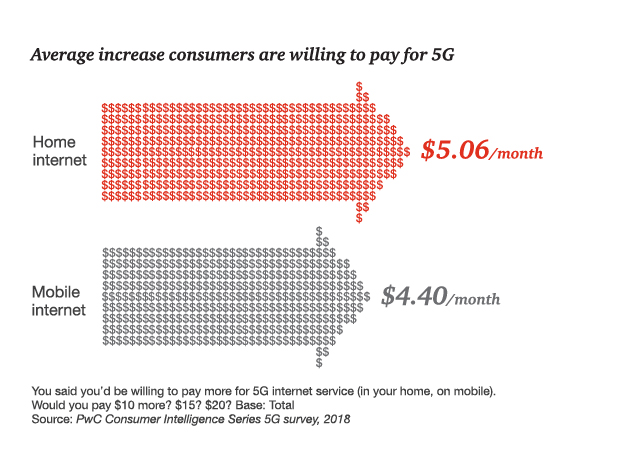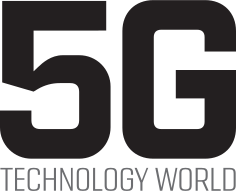
A new PwC survey found consumers are willing to pay more for in-home 5G internet service than mobile 5G. (Source: PwC)
As the wireless industry pushes ahead with 5G efforts, one concern has been the business case for the next-generation technology.
A new survey from PwC on consumer opinions related to 5G technology found that one-third of respondents said they’re willing to pay more for 5G if it delivers on its promise, particularly in terms of increased speed.
Notably, respondents were more likely to pay additional costs for 5G internet service in the home (33 percent) compared to mobile internet (31 percent). Those figures shifted when taking age into consideration, with 37 percent of consumers under 40 years old saying they would pay extra for in-home 5G service and 38 percent saying the same for mobile 5G.
Consumers also said they would pay more for in-home 5G broadband, on average willing to cough up an additional $5.06 per month, compared to $4.40 extra per month for mobile.
PwC noted that as most customers are less satisfied with their current in-home internet service and agree they are overpaying (51 percent agree) compared to mobile (36 percent). “What’s a marginal increase in price for a significant improvement in service?” PwC stated in the report.
Among major wireless carriers, Verizon is the one operator focused on next-generation home internet, launching its fixed wireless 5G in-home broadband offering in four cities at the beginning of October, as the other top carriers have been focused on forthcoming mobile launches.
When it comes to 5G in the home, 66 percent of internet users found portability “very appealing,” while 57 percent said the same thing about DIY-installation.
While reliability ranked highest as the top priority to consumers for both home internet (33 percent) and mobile (32 percent), it appears that speed is the reason customers will pay more.
Just under half of respondents named faster data speeds as a reason they would pay an upcharge for 5G home internet service, while 63 percent said the same for mobile.
“Interestingly, benefits having to do with video specifically hold more weight among mobile internet users. More would pay a premium for 5G if it provided ‘better quality video’ on their mobile device (29 percent vs. 25 percent of home internet users) and ‘decreased buffering while streaming video’ (25 percent vs. 19 percent),” the report found.
Importantly, most consumers do not feel an urgency to adopt new devices in order to use 5G, according to the survey. If 5G became available, only 26 percent said they would go out and buy a new compatible mobile device right away while 74 percent said they would wait until they become eligible for an upgrade.
Willingness to purchase a new smartphone for 5G service was higher among males under 40 (36 percent), African Americans (36 percent), and those who play video games regularly (34 percent).
AT&T just unveiled its first mobile 5G device from Netgear, which is a mobile hotspot rather than a phone and will become available later this year. Executives recently said the operator will launch mobile 5G services in select cities the next few weeks. AT&T has already named a dozen cities where it promises to launch 5G services by the end of the year.
Qualcomm recently shrunk the size of their 5G millimeter wave antenna modules by 25 percent, giving device manufacturers more flexibility in designing 5G smartphones, which are expected to launch early next year.
Sprint and LG have said the two are working to deliver the first 5G smartphone by the first half of 2019.
As providers look to capitalize on 5G, PwC recommends educating consumers on the technology and its capabilities, noting only 46 percent of respondents were familiar with 5G. Awareness was higher among males (57 percent) and in urban areas compared to rural (50 percent vs. 40 percent).
However, across all age segments 5G, once defined, was appealing to 93-98 percent of respondents across age groups, with 62 percent of consumers saying they found it “very” appealing.
“If it is ‘just’ faster and more reliable service, many will wait. If they see the other products and benefits, like longer battery life or portability, the adoption curve can be accelerated,” PwC said in the report.


